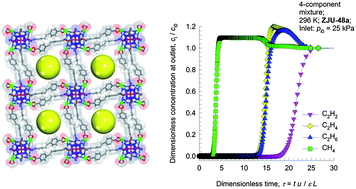A cationic microporous metal–organic framework for highly selective separation of small hydrocarbons at room temperature†
Abstract
A new three-dimensional cationic metal–organic framework Zn8O(EDDA)4(ad)4·(HEDDA)2·6DMF·27H2O (ZJU-48; H2EDDA =

Maintenance work is planned for Wednesday 1st May 2024 from 9:00am to 11:00am (BST).
During this time, the performance of our website may be affected - searches may run slowly and some pages may be temporarily unavailable. If this happens, please try refreshing your web browser or try waiting two to three minutes before trying again.
We apologise for any inconvenience this might cause and thank you for your patience.
* Corresponding authors
a
State Key Laboratory of Silicon Materials, Cyrus Tang Center for Sensor Materials and Applications, Department of Materials Science & Engineering, Zhejiang University, Hangzhou 310027, China
E-mail:
gdqian@zju.edu.cn
b
Department of Chemistry, University of Texas at San Antonio, One UTSA Circle, San Antonio, Texas 78249-0698, USA
E-mail:
banglin.chen@utsa.edu
Fax: +1 210-458-7428
c
Van't Hoff Institute for Molecule Sciences, University of Amsterdam, Science Park 904, 1098 XH Amsterdam, The Netherlands
E-mail:
r.krishna@uva.nl
d College of Chemistry and Materials, Fujian Normal University, 3 Shangsan Road, Cangshang Region, Fuzhou, China
e Department of Chemistry, Zhejiang University, Hangzhou 310027, China
A new three-dimensional cationic metal–organic framework Zn8O(EDDA)4(ad)4·(HEDDA)2·6DMF·27H2O (ZJU-48; H2EDDA =

 Please wait while we load your content...
Something went wrong. Try again?
Please wait while we load your content...
Something went wrong. Try again?
H. Xu, J. Cai, S. Xiang, Z. Zhang, C. Wu, X. Rao, Y. Cui, Y. Yang, R. Krishna, B. Chen and G. Qian, J. Mater. Chem. A, 2013, 1, 9916 DOI: 10.1039/C3TA12086D
To request permission to reproduce material from this article, please go to the Copyright Clearance Center request page.
If you are an author contributing to an RSC publication, you do not need to request permission provided correct acknowledgement is given.
If you are the author of this article, you do not need to request permission to reproduce figures and diagrams provided correct acknowledgement is given. If you want to reproduce the whole article in a third-party publication (excluding your thesis/dissertation for which permission is not required) please go to the Copyright Clearance Center request page.
Read more about how to correctly acknowledge RSC content.
 Fetching data from CrossRef.
Fetching data from CrossRef.
This may take some time to load.
Loading related content
